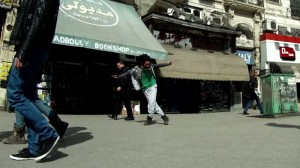
Courtesy of Dalia Naous
The independent 17-minute film Cairography, created by choreographer Dalia Naous and video artist Kinda Hassan, challenges what is deemed as “acceptable” in Egyptian streets. “Cairography is about answering the question how can we reclaim our personal space in a city where the border between the private and public space is blurred,” said Naous.
The film explores this issue creatively through dance.
The inspiration for the project came from the profound need to be free in a constricting society. “The idea for this project started when I was living in Cairo in 2010. At that time I was incapable of dealing with the daily pressure in the streets of Cairo. As a result I moved to Paris and to have some distance, and then I was able to rationalise my feelings and find an outlet to share them in an artistic manner,” Naous explained.
The film places dancers randomly in the streets of Cairo who then break out in dance, sometimes just one solitary dancer and other times a dance group. The film artistically highlights the self-consciousness that results from harassment and societal intrusion. For the making of the film Naous collaborated with Kinda Hassan: “I met with Kinda Hassan, a Lebanese video artist, and together we developed the ideas and translated them in a video-dance form, because Kinda has had her own, similar experiences in the streets of Cairo.”
The project was supported by Arab Fund Arts and Culture, Arab Digital Expression Foundation and the cultural organisation Al Mawred Al Thaqafi. “In addition we received great support from Salam Yousri, who helped us edit it, and Ahmad Magdy, who helped us shoot the balcony scene, (in which two women react to verbal harassment),” Naous said.
“And of course the participation of the great Egyptian dancers Nadine Emile, Samar Ezzat, Sherin Hegazy, Mohamed Fouad, Ahmed Al Gendy, Raafat Al Boumy, Aly Khamees, Nadim Bahsoun, Houssam Abdel Hameed.”
Although in the film the dancing seems like a spontaneous eruption of thoughts and emotions, there was a lot of planning involved, as Naous explained: “Before the shoot we organised a contemporary dance workshop for ten days where we worked with one Lebanese and nine Egyptian dancers.” She added that the purpose of the workshop was to collect testimonies about the social pressure felt by the Egyptian participants and “how we could all work together to face them, in addition to preparing ourselves emotionally and physically to start shooting the film in the streets”.
Shooting the film candidly in the streets of Cairo did come with some challenges. “The shoot itself was very difficult since we were filming with hidden cameras (iPhone, iPad, etc). This was to preserve the spontaneous and authentic reaction of the public, because once the crowd identifies a camera or a performance in the street they will stop interacting actively and will become passive spectators which would have lead to losing the main goal of our research,” said Naous. “It was really difficult to be discreet in the streets since we were always feeling observed by the people around us just by simply standing in one spot for a short period of time.”
Naous and Hassan plan to take the idea to a regional level. “We would like to repeat this experience with dancers and non dancers in different cities in the Arab world. The idea is to try to combine these different experiences in a documentary that showcases different points of view about social pressure and how to deal with the social censorship.”
They are also planning to participate in several film festivals around the world.
People’s reactions were generally positive. Naous recalled: “[Viewers] were touched by the way we approached the subject away from clichés. They were eager to see more and were surprised by the reaction of the people in the streets, which contradicted their initial expectations that the performers would face big trouble or difficulties as they attempt to confront their fears in public.”




